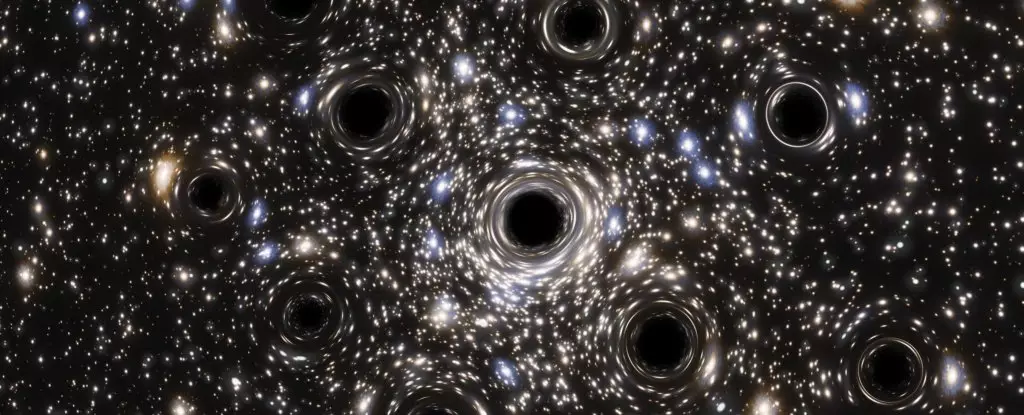In the vast expanse of the universe, few celestial phenomena are as captivating as globular clusters — dense collections of ancient stars that resemble cosmic relics from the universe’s early epochs. Among these, Palomar 5 stands out as an intriguing subject of study due to its extensive tidal stream and the potential presence of stellar-mass black holes. Located approximately 80,000 light-years away, Palomar 5 stretches over 30,000 light-years, acting as a critical piece in the cosmic puzzle of star formation and evolution.
Globular clusters contain tens of thousands to millions of stars, all having formed contemporaneously from the same primordial gas cloud. The Milky Way boasts around 150 of these clusters, offering astronomers valuable insights into the galactic history and dark matter distribution in the universe. However, recent advancements in observational technology — especially through instruments like the Gaia space observatory — have shifted attention toward tidal streams, elongated ribbons of stars that materialize from the gravitational interactions of globular clusters with surrounding matter.
The Discovery of Palomar 5’s Secrets
In a groundbreaking discovery, researchers have indicated that Palomar 5 may harbor over 100 stellar-mass black holes within its core. This discovery raises questions regarding the dynamics and evolution of both the cluster itself and the stars forming its tidal stream. Astrophysicist Mark Gieles, along with his team, has investigated these aspects by implementing detailed simulations of the cluster, helping illuminate the process of star ejection that leads to the formation of tidal streams.
The structure of Palomar 5 is fascinating; it has an unusually loose distribution of stars, along with a tidal stream that spans more than 20 degrees of the sky. This makes it an exceptional candidate for studying how gravitational interactions shape star formations and movements over time. Gieles posits that tidal streams could be remnants of disrupted star clusters. By thoroughly studying Palomar 5, astronomers hope to unlock the secret mechanisms behind the formation of these sprawling stellar highways.
A significant aspect of the study involved running N-body simulations, which allowed researchers to recreate the orbits and evolutionary paths of stars in Palomar 5. The hypothesis that sparked attention was the possible existence of a population of black holes within the cluster’s center. The gravitational effects of these black holes would play a crucial role in the dynamics of the cluster, potentially flinging stars into the surrounding tidal stream.
The findings revealed that the presence of black holes significantly alters the expected star-to-black hole ratio; the cluster is predicted to contain about three times more black holes than previously thought. Specifically, black holes comprise over 20% of Palomar 5’s total mass, with each black hole weighing approximately 20 solar masses. These massive objects formed from supernova explosions of once-massive stars during the cluster’s infancy.
The simulations indicate that Palomar 5 is destined to disintegrate in about one billion years. As it approaches dissolution, the remaining stellar bodies will primarily consist of black holes orbiting the galactic center. This scenario is not unique to Palomar 5; it highlights a broader trend among globular clusters, suggesting that many of them may ultimately dissolve into tidal streams, with their remnants potentially harboring black holes.
This understanding opens the door to exploring the interactions of black holes within clusters, including the elusive search for middleweight black holes. According to astrophysicist Fabio Antonini, a significant portion of binary black hole mergers likely occurs in these environments. However, the most challenging aspect remains discerning the true population of black holes since they are inherently invisible.
A Bright Future for Stellar Exploration
The study of Palomar 5 could mark a transformative step in our understanding of the universe’s structures and the behavior of celestial bodies. Enhanced observational techniques, including those utilized by Gaia, are breathing new life into our comprehension of tidal streams and black hole populations.
These advancements will not only refine our understanding of globular cluster dynamics but will also aid in uncovering deeper cosmic mysteries. As scientists continue to probe the dynamics of clusters like Palomar 5, we edge closer to unveiling the intricate narrative of our galaxy and the universe beyond it. The implications extend far, shaping our perspectives on star formation, black hole distributions, and the ultimate fate of various stellar systems.


Leave a Reply